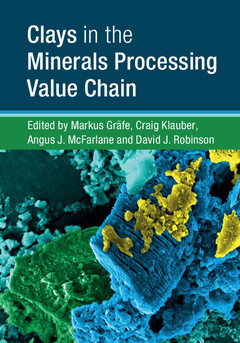Description
Clays in the Minerals Processing Value Chain
Coordinators: Gräfe Markus, Klauber Craig, McFarlane Angus J., Robinson David J.
A review of the issues surrounding clays in the mineral processing value chain, from mining to processing and waste disposal.
Language: English
Subject for Clays in the Minerals Processing Value Chain:
Publication date: 08-2017
462 p. · 17.8x25.3 cm · Hardback
462 p. · 17.8x25.3 cm · Hardback
Description
/li>Contents
/li>Biography
/li>
Clays are increasingly becoming a major problem in the mining, extraction and value-adding processes for a wide range of commodity raw materials. Clays can impact negatively on virtually every unit process within the mining and minerals processing sector, having long-term environmental implications that go well beyond the lifetime of the mining operation. This book is the first to compile, explain and evaluate the effects of clays in the mineral processing value chain, from mining to minerals processing, and finally, tailings disposal. Focusing on topics from the chemistry and rheology of clays to their detection and dissolution behaviour, this book provides comprehensive coverage of the effects on processes such as settling, preg-robing, flotation and comminution. It is an excellent reference for professional mineralogists and geologists, industrial engineers, and researchers interested in clays and clay minerals.
List of contributors; Foreword; Preface; 1. Clays and the mineral processing value chain (MPVC) Markus Gräfe, Angus J. McFarlane and Craig Klauber; 2. Fundamentals of clays: surface and colloid science and rheology Elizaveta Forbes and Andrew Chryss; 3. Leaching and solution chemistry Jian Li, Angus J. McFarlane, Craig Klauber and Peter Smith; 4. Identification and quantification of clays Mark Raven and Peter Self; 5. Clays by deposit type Martin Wells, Erick Ramanaidou, Carsten Laukamp, Kai Yang and Mark Pownceby; 6. Exploration and discovery Carsten Laukamp, Erick Ramanaidou, Martin Wells and Kai Yang; 7. Clay minerals in flotation and comminution operations Elizaveta Forbes, Mark Ma and Warren Bruckard; 8. Solid-liquid separation of clay tailings Phillip Fawell; 9. Effects of clay in tailings handling and storage Andrew Chryss; 10. Knowledge and practice gaps and research priorities for clay-related phenomena in the minerals processing value chain (MPVC) Markus Gräfe, Angus J. McFarlane and Craig Klauber; Glossary; Index.
Markus Gräfe is the National Coordinator of the Department of Soil and Water Management at Ecuador's National Agricultural Research Institute (IN-IAP), and an Associate Editor for the Journal of Environmental Quality. His research focuses on Ecuador's soil mineralogy and chemistry, stretching from the Amazon Basin across the Andes to the Pacific Ocean and Galapagos.
Craig Klauber came to mineral processing research from a background in fundamental surface chemistry and spent several decades as a research scientist at the Commonwealth Scientific and Industrial Research Organisation (CSIRO). His work principally focuses on utilizing X-ray photoelectron and Auger spectroscopies in order to solve problems in mineral processing systems. He is currently an Adjunct Professor at Curtin University of Technology, Perth.
Angus J. McFarlane is a senior geoscientist for the Commonwealth Scientific and Industrial Research Organisation (CSIRO) Mineral Resources, with expertise in applied minerology and geometallurgy. He is currently working on projects which enable scientists and mining professionals to link ore properties and their behaviour during mining processes via improved characterization and data analytics techniques.
David J. Robinson is the Group Leader for Base and Precious Metals Processing within CSIRO, where he has been since 2007 following a twenty-year career at Anglo Platinum and Anglo American. He leads a number of research- and pilot-scale projects in base metals hydrometallurgy in areas such as mineral characterization, geometallurgy, leaching, refining and solvent extraction.
Craig Klauber came to mineral processing research from a background in fundamental surface chemistry and spent several decades as a research scientist at the Commonwealth Scientific and Industrial Research Organisation (CSIRO). His work principally focuses on utilizing X-ray photoelectron and Auger spectroscopies in order to solve problems in mineral processing systems. He is currently an Adjunct Professor at Curtin University of Technology, Perth.
Angus J. McFarlane is a senior geoscientist for the Commonwealth Scientific and Industrial Research Organisation (CSIRO) Mineral Resources, with expertise in applied minerology and geometallurgy. He is currently working on projects which enable scientists and mining professionals to link ore properties and their behaviour during mining processes via improved characterization and data analytics techniques.
David J. Robinson is the Group Leader for Base and Precious Metals Processing within CSIRO, where he has been since 2007 following a twenty-year career at Anglo Platinum and Anglo American. He leads a number of research- and pilot-scale projects in base metals hydrometallurgy in areas such as mineral characterization, geometallurgy, leaching, refining and solvent extraction.
© 2024 LAVOISIER S.A.S.

